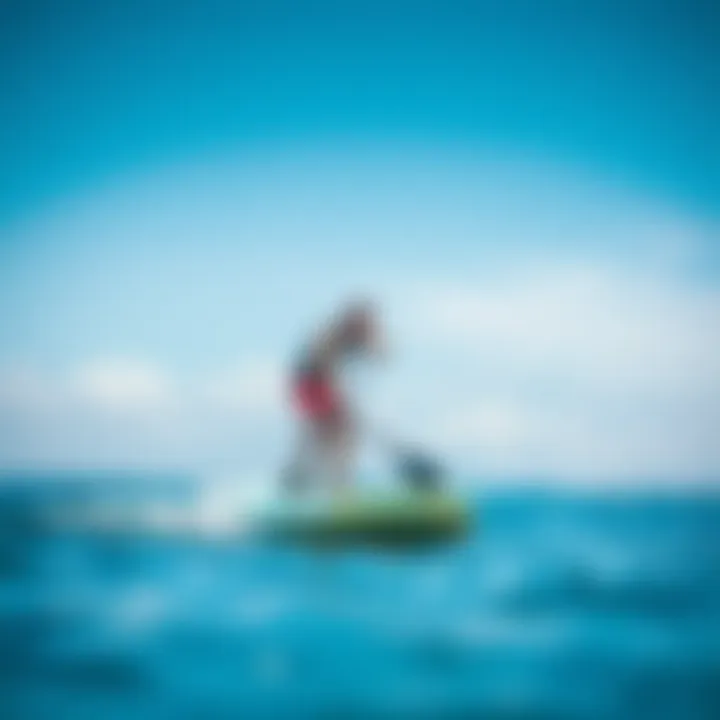Exploring the Impact of Paddle Board Width


Intro
When it comes to stand up paddle boarding, width is often an overlooked yet critical factor that heavily influences your riding experience. It shapes your board's stability, speed, and overall performance on the water. For many seasoned paddle boarders as well as newcomers, understanding the impact of the board's width can be the difference between a thrilling ride and a frustrating wipeout.
This article delves into the myriad of ways board width affects not only how well you paddle but also how enjoyable that experience can be. From casual paddlers who enjoy gliding across serene lakes to those who tackle surf breaks and challenging conditions, there’s a board width that fits your skill level and style.
Before choosing your paddle board, take into account various widths and their specific benefits. Whether you’re looking for exceptional stability for recreational use or a narrower profile for speed and maneuverability, exploring this topic is crucial for find your ideal board. Let’s jump into the gear and equipment, where we position board width within the broader context of paddle equipment.
The Importance of Board Width
When it comes to stand up paddle boarding, the width of your board isn't just a matter of aesthetics; it plays a pivotal role in the overall performance and experience on the water. A paddle board’s width can be a defining factor influencing stability, speed, maneuverability, and even the comfort level of the rider. The nuances in selecting the right board width can mean the difference between a leisurely day on a calm lake and a thrilling ride over rolling waves.
Defining Width in Paddle Boards
Width refers to the measurement across the paddle board's deck. It usually ranges from about 24 to 36 inches, with the average being around 30 inches. But, why does it really matter? Width impacts stability directly. A wider board may seem clunky at first, but it provides a larger surface area to stand on, reducing the chances of you taking an unintended plunge into the water. On the flip side, a narrower board may cut through waves with ease but might require more balance and advanced paddling skills. This aspect of defining width sets the stage for understanding its broader implications in paddle boarding.
How Width Affects Stability
Stability is arguably one of the most significant factors to consider when choosing a paddle board. A broad surface area grants more buoyancy, which helps in keeping the board upright even when the waters get choppy. This is particularly essential for beginners, who often benefit from the ease of stability a wider board provides.
Here’s a clearer picture:
- Wide Boards (30-36 inches): These boards cater to casual paddlers and those wanting to take it slow. You won't win any races, but you'll feel confident gliding across calm waters.
- Medium Boards (28-30 inches): Great for those who want a balance of speed and stability. They can handle a variety of conditions without compromising too much on either front.
- Narrow Boards (24-27 inches): Designed for experienced paddlers, these boards are optimized for speed and agility. But with reduced stability, they demand a greater level of skill and comfort on the water.
To illustrate, imagine you're on a family outing; choosing a wide board could make it easier to bring along kids or dogs, enhancing everyone’s experience. However, if you're eyeing a competitive race, you would likely lean towards a narrower design to maintain speed. This duality of stability versus performance is where understanding board width becomes crucial.
"Choosing the right paddle board width is akin to selecting the right tool for a job; it can make all the difference in your success and enjoyment."
For further reading about paddle boarding dynamics and considerations, check out Wikipedia on Paddle Boarding and Britannica's guide.
Understanding these elements can help paddlers make enlightened decisions, ensuring the best fit for their needs and promoting a more enjoyable ride.
Standard Widths and Their Uses
When it comes to selecting a stand up paddle board, the width plays a crucial role in how the board performs in different scenarios. Width affects not only stability but also maneuverability, speed, and overall experience on the water. Understanding the nuances of board width is essential for anyone looking to enhance their paddle boarding adventures.
In this section, we'll delve into the three primary categories of board widths—narrow boards, wide boards, and average width boards—each with its own set of benefits and considerations. Knowing the distinct characteristics of these widths can help paddlers make informed decisions tailor-fitted to their preferences and skills.
Narrow Boards
Narrow boards, typically ranging from approximately 24 to 28 inches wide, are primarily designed for speed and agility. These boards glide through the water with remarkable ease, making them a popular choice among competitive racers. If you’re in the market for some serious performance gains during races, narrow boards can provide that extra edge.
However, it’s worth noting that the slender design may compromise stability, especially for beginners or those not accustomed to maintaining balance on such a slim profile. Rather than relying on the board's width to stay upright, paddlers must engage their core muscles and develop their paddle stroke technique to keep steady.
In competitions, where every second counts, the benefits of a narrow board become evident:
- Speed: They cut through the water more efficiently.
- Maneuverability: Easier to navigate tight turns and corners.
- Lightness: Often made from lighter materials, making them easier to transport and handle.
Wide Boards
On the opposite end of the spectrum, wide boards offer enhancements in stability and comfort, generally ranging from 30 to 36 inches wide. This increased breadth is ideal for beginners or those targeting leisurely paddling, such as family outings or yoga sessions on the water.
Wide boards are built to be forgiving; they provide a stable platform that eases the learning curve for novice paddlers. With a wider base, these boards distribute the weight more evenly, minimizing the likelihood of tipping over. The design is especially beneficial for users with larger frames or those carrying additional gear.


Advantages of wider boards include:
- Enhanced stability: Better balance makes it easier for beginners.
- Versatility: Suitable for many activities, including fishing and yoga.
- Load Bearing: Can accommodate more gear without sacrificing performance.
Average Width Boards
Lastly, we have average width boards, typically falling between 28 to 30 inches. These boards aim to strike a balance between the performance attributes found in narrow boards and the stability offered by wider boards.
For versatile paddlers who engage in a mix of recreational paddling, fitness activities, and casual racing, average width boards can be an excellent choice. They cater to a wide range of skill levels and provide adequate speed without severely compromising stability.
Key benefits of average width boards include:
- Performance Balance: Suitable for both speed and stability needs.
- Adaptability: Great for various activities, from touring to light competition.
- Accessibility: A good fit for paddlers who want a little bit of everything without specializing too much.
Choosing a stand up paddle board width is not just about numbers; it’s about finding the right fit for your paddling style and comfort level. With the right board width, you'll enjoy every trip on the water, whether you are racing down a course or just exploring local lakes.
Selecting the Right Width for Your Needs
When it comes to paddle boarding, finding the right board width is like choosing the right pair of shoes — it should fit your needs and provide comfort during use. The width of a stand up paddle board significantly impacts not just how stable it feels on the water, but also affects your overall paddling performance and enjoyment. If you step onto a board that doesn’t complement your style or weight, it could be like trying to ride a bicycle with flat tires. Therefore, selecting the right width is pivotal for maximizing your time on the water.
Skill Level Considerations
Your skill level is among the most crucial factors in board width selection. If you’re new to paddle boarding, a wider board generally offers better stability, which is key for beginners still finding their balance. For instance, boards around 32 inches wide provide a generous surface area that can make a newbie feel as if they’re gliding over calm seas, reducing the chances of tipping. Beginners might also find that boards designed for recreational paddling allow for more forgiving movements, letting them build confidence gradually.
Conversely, more experienced paddlers might opt for narrower boards as they tend to be faster and easier to maneuver. The trade-off is stability; a narrower board can be quite tippy for someone who isn’t skilled in maintaining balance. This means that seasoned SUP riders must assess their levels and know when to switch from stability-focused options to performance-oriented boards. It’s essential to warm up to a narrower design if you’ve spent a lot of time on a wider one; trying to shift gears too quickly can lead to unexpected splashes.
Weight and Stability Factors
Weight plays a pivotal role in determining the appropriate board width as well. A heavier rider will naturally require a wider board to achieve proper floatation and stability. Just as a larger load on a slender bridge could lead to sagging, a heavier paddler on an overly narrow board may find themselves struggling to keep it afloat. Choosing a width that adequately supports your weight is crucial because it can significantly affect your paddling experience. Boards that are too narrow can lead to frustration and hinder progress — not something you want when aiming to enjoy a leisurely day on the water.
Moreover, the weight distribution varies from person to person, which means that two individuals of the same weight might require different board widths based on their unique paddling styles and movements. Thus, it's worthwhile to consider your body type, weight, and how you plan to maneuver on the board.
Intended Use Cases
Different paddling scenarios call for different board widths. What works well for a casual paddle around a lake might not serve the same purpose during a racing event or while catching waves. If you're likely to spend your time traversing calm waters with gentle strokes, a board with a width of around 30 to 32 inches might enhance stability, allowing you to soak in the scenery rather than worrying about falling off.
If you lean more towards racing or competitive paddling, you might gravitate towards a narrower board that offers less drag and more speed. These boards typically range from 24 to 28 inches and are optimized for speed. While they require a more skilled approach to balance, they can deliver significant advantages in terms of performance.
In contrast, surf-style paddle boards typically require a bit of extra width for stability on the waves. With a width of around 30 inches or more, they’ll allow surfers to navigate better while turning and riding the waves.
"Remember, the right board width serves as a bridge connecting your skills, body weight, and paddling goals. Take your time in selecting one that fits your unique style!"
Board Width and Performance Dynamics
When it comes to paddle boarding, the width of your board plays a pivotal role in how you experience the water. Board width can be a game changer, influencing not just performance but also the rider's connection to the water. A well-chosen width brings benefits that enhance both skill and enjoyment. Riders need to consider how specific dynamics of board width translate into real-world paddling experiences.
Speed vs. Stability
The relationship between speed and stability is a balancing act that every paddler grapples with. On one hand, narrower boards slice through the water with speed and agility, making them more favorable for racing or long-distance paddling. These boards allow an easier glide, essential for covering miles efficiently. However, the trade-off is noticeable because a narrower width can lead to a tippier experience, where even a slight shift in weight could send the paddler into a splashy situation.
Conversely, wider boards enhance stability, ideal for beginners or those looking to relax on the water. This added stability allows beginners to find their footing, reduce the fear of capsizing, and enjoy the scenery rather than worrying about falling in. On calm water, these boards promote a sense of confidence; however, they may not match the speed capabilities of their narrower counterparts.
In this context, it's crucial for paddlers to gauge their priorities. If gliding effortlessly is your goal, a narrower board may serve well, but for those craving a stable platform or looking to enjoy leisurely paddling, width becomes an asset. It should be noted that conditions like wave size and water currents also affect this dynamic, thus requiring consideration of both personal comfort and environmental factors.
"Choosing the right board width does more than improve performance; it transforms your relationship with the water."


Turning Radius and Handling
Another significant aspect influenced by board width is the turning radius. When hitting the waves or navigating tight spots, the ability to turn swiftly is key for an enjoyable experience. Narrow boards typically allow for sharper turns, as they pivot more easily underfoot. This agility makes them preferred by surfers wanting to catch waves and maneuver quickly.
In contrast, wider boards are known for their slower turning capabilities. They may require the paddler to put in a bit more effort to change direction. While this might lack the finesse of narrower boards, wider boards have their own rewards. Their wide stance can help paddlers glide smoothly into a turn, allowing for a comfortable and controlled approach.
Riders who plan to explore diverse water conditions might want to consider how width influences handling. For example, if you frequently find yourself in crowded waters or spots with obstacles, having the ability to turn swiftly becomes invaluable. Whether you're dodging fellow enthusiasts or adjusting to sudden gusts of wind, board width influences how you manage these challenges.
Assessing Different Paddle Boarding Styles
When it comes to stand up paddle boarding, understanding various paddling styles can significantly impact your experience and performance on the water. Whether you're leisurely gliding across a calm lake, competing in a race, or tackling waves, the width of your paddle board plays a crucial role in how you engage with each style. The difference in board width affects not just stability but also speed, maneuverability, and comfort, making it essential to consider the specific dynamics of each use case.
Recreational Paddling
Recreational paddling is often viewed as the most accessible form of stand up paddle boarding, perfect for leisurely outings with friends or family. Choosing the right board width in this scenario is paramount. A wider board offers greater stability, which is especially beneficial for beginners or those who may not yet have a firm grasp on balance. The wider surface allows you to feel more secure standing upright as you paddle, reducing the likelihood of slips that can dampen your experience.
- Benefits:
- Increased stability makes it easier for anyone, regardless of skill level, to enjoy the outing.
- More room for pets or extra gear if you’re packing for a day on the water.
When selecting a board for this style, it's wise to aim for one that balances width with versatility—this ensures that whether you’re on calm waters or light chop, you can maintain comfort and confidence.
Racing and Competition
On the flip side, racing demands a different approach altogether. Paddle boards designed for races tend to be narrower, which supports higher speeds at the cost of some stability. In this type of paddling, competitors prioritize cutting through the water more efficiently, focusing on performance rather than leisurely enjoyment. A narrower board creates less drag, allowing for faster strokes, crucial in competitive settings.
- Considerations:
- Balance is crucial in narrower designs. Experienced racers often adapt quickly, pushing their limits in handling but might face a steeper learning curve for newcomers.
- Training and conditioning play a significant part in effectively using a racing board.
Be mindful that while you might sacrifice a bit of stability for speed, proper technique can make all the difference in how you handle your board during a race.
Surfing with SUP Boards
Finally, let's not forget surfing with SUP boards. Surfers often prefer shorter, wider boards to catch waves effectively. This style combines balance with agility, allowing paddlers to maneuver quickly as they ride waves. A wider board here ensures buoyancy while still giving you the ability to tilt and turn, which is critical while navigating the ever-changing wave dynamics.
- Highlights:
- Enhanced paddling power helps in catching the waves sooner.
- Wider boards allow for more room to place feet for stable riding.
In this context, width can significantly affect how well you perform in waves, and finding the right balance between width and length is essential for maximizing your surfing experiences.
Overall, evaluating these different paddle boarding styles not only helps you select the right board but also enhances your enjoyment on the water. Remember, it's not merely about width; it's how that width interacts with your personal paddling habits and the environment you are exploring.
The Influence of Width on User Experience
When talking about stand up paddle boards, width is not just a number. It’s a crucial factor that can greatly shape the user experience. A board's width can affect everything from how it feels on the water to how easy it is to navigate. Width impacts stability, comfort, and even how quickly a rider can hop on and start paddling around.
Comfort and Ease of Use
A wider paddle board tends to provide more surface area. This typically means increased stability. For those who might not be the most graceful on water, having that extra cushion can make a world of difference.
Imagine paddling out on a wider board; you’re less likely to tip over when you have a solid footing. This extra width allows a rider to feel at ease, as oscillations caused by waves won’t shake them off as easily. Furthermore, for anyone looking to carry extra gear, snacks, or even a furry companion, those wider boards provide the necessary space to do so comfortably. When you don’t feel cramped or constantly worried about your balance, your experience on the water can turn into pure joy. Comfort is key here—good alignment and space can help in avoiding fatigue, making your paddle sessions much more enjoyable.


Learning Curve for Beginners
For newcomers to the sport, the width of a paddle board can either encourage or deter them from diving deeper into paddleboarding. Generally, broader boards are more forgiving. Beginners often gravitate toward wider options since they give a steady platform while the user is finding their sea legs. It’s like learning to ride a bicycle with training wheels: having a stable base allows you to gain confidence without worrying about tipping over at every little wave.
On the flip side, if a beginner starts on a narrow board, the stakes can feel higher. They might find themselves flailing around, increasing their chances of falling in the water, which can be discouraging. Plus, the learning process becomes a lot more daunting—and let’s face it, no one wants to end their first day on the water feeling frustrated.
Ultimately, the width of the paddle board serves as a significant factor in shaping user experiences, especially for those who are just starting out. Choosing the right width can make for a smooth sailing journey from novice to seasoned paddler. Whether it's in comfort during use or the ease of mastering new skills, understanding how width feeds into the overall experience is vital for anyone considering taking the plunge into paddleboarding.
"Choosing the right board width is not just about stability; it's also about ensuring you enjoy the journey on the water fully."
By acknowledging these elements, users can better find a board that suits their comfort and learning styles, paving the way for memorable experiences on the water.
Common Misconceptions about Paddle Board Width
When it comes to stand up paddle boarding, width is a defining characteristic that affects not just stability but also performance and overall enjoyment on the water. However, there's a lot of misunderstanding surrounding board width, leading both novice and seasoned paddlers astray. Clearing up these misconceptions creates a foundation of knowledge essential for making informed decisions when selecting a paddle board. Through addressing these common beliefs, paddlers can appreciate the diverse range of options available and find the best fit for their specific needs.
Wider Boards are Always Better
One prevailing myth is that wider boards are a surefire way to guarantee stability. While it's true that width can enhance support for the rider, it's not the only piece of the puzzle. Wider boards bring their own set of challenges. Increased surface area can slow a paddle board down, making its glide less efficient, particularly for those who prefer speed. This can be frustrating for competitive paddlers and may even detract from a recreational paddle experience if speed is a priority.
Folks often latch onto the idea that a wider board equates to an "easier ride." Yes, they are perfect for beginners seeking a stable platform, especially in choppier waters. However, the balancing act between ease and performance is delicate. You'll find that narrower boards are usually favored by experienced paddlers, allowing them to cut through the water more swiftly, improving maneuverability. In essence, wider does not automatically mean better; it boils down to what you hope to accomplish while paddling.
Keep in mind: Each paddler's preferences vary. A wider board might be your best bet if you're looking for relaxation or casual paddling, but competition or speed junkies should explore the narrower options.
Narrow Boards are Only for Experts
Another common misconception is that narrow boards belong solely in the hands of skilled paddlers. This could not be farther from the truth. The idea that only those with advanced skills can handle a narrow board does a disservice to new riders seeking to grow in their capability. While it’s right that a narrow board requires a certain level of balance and control, many entry-level paddle boards are designed to accommodate a range of skill levels.
Interest in narrowing board designs also sparks from the need for performance in various environments. Paddlers who engage in racing or swift water navigation often find narrow boards to be advantageous due to their streamlined shape. Yet, this doesn't mean novices should steer clear. With a bit of practice and acclimatization, paddlers can effectively learn the ropes using narrower boards without feeling overwhelmed.
The key is to take lessons, build confidence, and allow yourself the time to adjust. Not all narrow boards are equal; many brands offer versatile models specifically designed with stability features that help reduce the learning curve even for beginners.
In sum, labeling paddle boards as narrow only for experts reflects a misunderstanding of the equipment and the diverse capabilities design provides. Understanding the true characteristics of board width helps you navigate your choices with clarity.
Ending
Misconceptions surrounding paddle board width can lead to misguided decisions, affecting both performance and enjoyment on the water. Grasping the nuances involved is crucial, enabling paddlers to match their boards with their skill levels and intended uses effectively. Take the time to explore options, keeping in mind that both width and personal preferences will heavily influence your experience. Educating oneself about these common fallacies is perhaps the first paddle stroke towards a more enjoyable journey on the water.
Future Trends in SUP Board Designs
As paddle boarding continues to gain traction across the globe, innovations in design and materials are shaping the future of stand up paddle boards. These trends go beyond simple aesthetics; they enhance performance, cater to evolving user needs, and offer a glimpse into how technology can advance water sports. Understanding these trends helps paddlers choose equipment that matches their ambitions, skills, and environmental consciousness.
Innovations in Board Width and Shape
Manufacturers are now experimenting with widths and shapes like never before. Wider boards were once deemed the best option for stability, but innovations have led to more nuanced designs that balance speed and stability.
Some notable developments include:
- Variable Width Designs: Some brands have introduced boards with adjustable widths, allowing users to customize their boards based on conditions. For example, a board could be wider for lake paddling and narrower for ocean racing.
- Rocker Profiles: Boards are featuring different rocker shapes that influence how they cut through water while balancing the width. A board with a pronounced rocker can be wider, allowing for better turns without losing speed.
- Hybrid Designs: Combining elements from surfing to racing through innovative shapes is on the rise. Boards that shift from wider to narrower at different points allow for increased versatility in handling.
These innovations not only enhance performance but also make boards more adaptable to various paddling conditions, offering riders a unique advantage when exploring different waters.
Sustainability and Material Advances
Sustainability is becoming more than just a buzzword—it's an essential part of modern paddle board manufacturing. The movement towards greener materials is pushing brands to rethink how they produce boards without compromising on quality or performance. Products now include recycled materials and eco-friendly resins that decrease environmental impact.
Several initiatives and advancements in this area include:
- Recycled Plastics: Some paddle boards are being crafted with materials repurposed from ocean waste or post-consumer plastics, allowing surfers to contribute to environmental cleanup while enjoying their sport.
- Biodegradable Resins: These resins not only enhance durability but decompose more naturally, reducing the long-term footprint of the production process.
- Sustainable Manufacturing Processes: Techniques that minimize energy consumption and waste during production are becoming the industry standard. This could involve using solar power in factories or reducing water usage in the creation of boards.
This shift not only appeals to eco-conscious consumers but sets a new benchmark for quality and responsibility in the paddle boarding community.
"As surfers and paddle boarders, we can ride the waves while being stewards of our oceans, ensuring future generations can enjoy them too."
In summary, keeping an eye on future trends in SUP board designs is vital for anyone who is serious about paddle boarding. Embracing innovations in width, shape, and materials leads to a more sustainable and enjoyable experience on the water.





